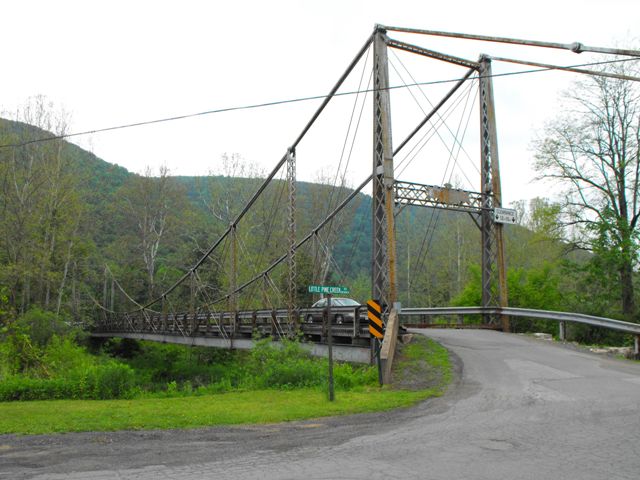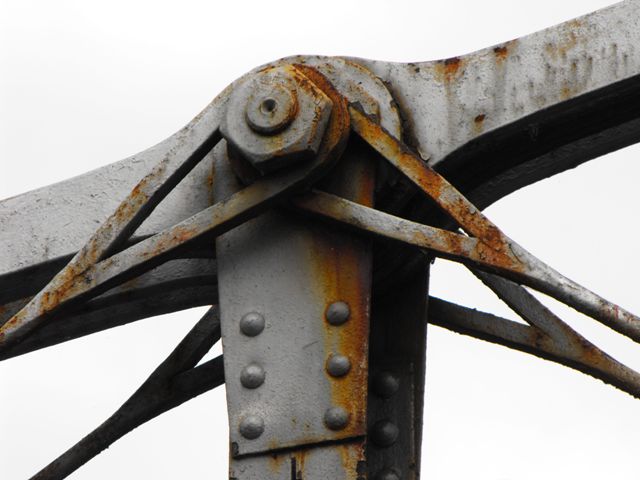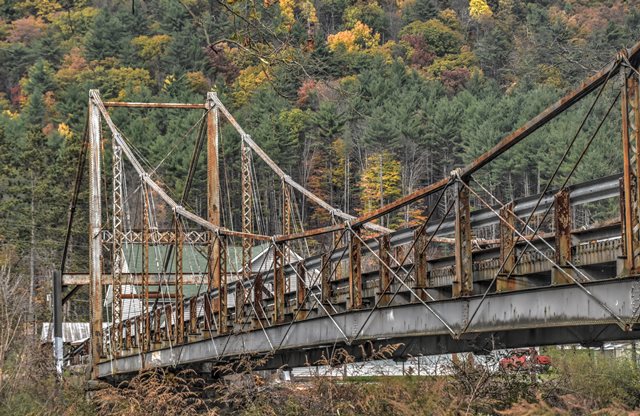We Recommend:
Bach Steel - Experts at historic truss bridge restoration.
BridgeHunter.com Phase 1 is released to the public! - Visit Now
Lower Bridge
English Center Bridge

Primary Photographer(s): Nathan Holth and Rick McOmber
Bridge Documented: May 29, 2010 and October 29, 2016
English Center: Lycoming County, Pennsylvania: United States
1891 By Builder/Contractor: Dean and Westbrook of New York, New York
Not Available or Not Applicable
300.0 Feet (91.4 Meters)
306.0 Feet (93.3 Meters)
15 Feet (4.57 Meters)
1 Main Span(s)
414001027000000

View Information About HSR Ratings
Bridge Documentation
Bridge Status: As of 2019, slated to be extensively rehabilitated, with partial eyebar replacement and full stiffening girder replacement.
View Archived National Bridge Inventory Report - Has Additional Details and Evaluation
View Historic American Engineering Record (HAER) Documentation For This Bridge
HAER Drawings, PDF - HAER Data Pages, PDF
View The National Register Nomination Form For This Historic Bridge
About This Bridge
This is a bridge so bizarre and unique that it defies classification. It has been called a truss bridge, a suspension bridge, and even a "two-hinged inverted trussed arch" type bridge. The confusion arises from the fact that this bridge has the characteristics of an eyebar chain suspension bridge, but it also has diagonal members, which are not part of a normal suspension bridge. According to the Historic American Engineering Record, a structural analysis was composed and the bridge was found to function more as a truss than a suspension. Further, they suggested that based on their analysis, the bridge could be called a two-hinged inverted trussed arch.
Among those structure type choices, HistoricBridges.org has categorized the bridge as a suspension bridge, because of the manner in which the eyebar chain continues past the towers beyond the bridge span itself down to an anchorage. Further, although the diagonal members/braces may act to help stiffen the bridge, the structure's design also features a more traditional form of suspension bridge stiffening, in the form of a shallow deck plate girder, which contributes to the suspension bridge appearance. Finally, classifying it as a suspension bridge on this website seemed logical because not only would most average people looking for this bridge think of the design as a suspension, but the eyebar suspension bridge type would have been a well-known and familiar bridge type in 1891, while on the other hand it is questionable whether engineers in 1891 even knew of a bridge type called a two-hinged inverted trussed arch, even if modern engineering analysis does prove that the bridge functions as such.
The take away point to all the above issues with classifying the bridge is to realize how this bridge is so rare and unique that it defies classification. Some of the most well-known bridge engineers have come at odds with each other trying to describe the bridge. So while HistoricBridges.org categorizes the bridge as a suspension bridge, realize that in reality describing this bridge is not as simple as that.
Eyebar chain suspension bridges were a type of bridge mostly built during the 1800s, although some examples continued to be built in the early 20th Century. Eyebar chain suspension bridges were more common in Europe, particularly Britain and France, where a number of examples remain today.
The Lower Bridge is the smaller of two nearly identical such bridges that were built in the area in 1891, and this bridge is the only one of those two that remains today, the other bridge, called the Upper Bridge, was replaced in 1932. The smaller Lower Bridge has a total length from anchorage to anchorage of 475.7 Feet (145 Meters), and the actual span over the river is 300 feet. The bridge contains 12 panels.
Jim Barker, a historic bridge engineer, commented that he was fascinated by this bridge and was impressed with how it made one of the most efficient uses of materials possible, meaning the total amount of metal in this bridge for its length is relatively small, and constructing a more traditional structure such as a Pratt truss bridge would have used a lot more material in comparison.
The efficient design of the Lower Bridge speaks to the ingenuity of Dean and Westbrook, the engineers and contractors for the bridge. This is particularly interesting, because Dean and Westbrook do not immediate give the impression of being heavy duty engineers. This is because their main claim to fame was erecting bridges fabricated by another company, since they were agents of the Phoenix Bridge company, and commonly acquired and erected truss bridges that were fabricated by the Phoenix Bridge Company with their trademark Phoenix columns. Dean and Westbrook would take their bridges, erect them, and affix their ornate and distinctive plaque to the bridge. The Lower Bridge does not have Phoenix columns and it does not appear that Phoenix Bridge Company was involved. The Lower Bridge does have the traditional Dean and Westbrook plaque design however. Given that so many bridges built by Dean and Westbrook were associated with Phoenix Bridge, the Lower Bridge is noteworthy as a rare example of a bridge that was entirely the work of Dean and Westbrook. Given the complexity and efficiency of the design, it reveals that Dean and Westbrook were more than just salesmen to be sure, and indeed were very gifted engineers.
Historic American Engineering Record has composed a lengthy and very in-depth narrative for this historic bridge, so be sure to view their documentation using the links at the top of this narrative for more information about this bridge's history, design, alterations, and significance.
Also, the photo above from the Pennsylvania Historical and Museum Commission is undated but shows the bridge prior to the replacement of (original?) pole railings on the bridge with modern Armco style guardrails. Click on the thumbnail to see a full size image.
Preservation Recommendations
This bridge should be given the highest possible preservation priority, and a preservation commitment should exist that ensures the bridge will always be maintained and preserved in perpetuity. The extremely high level of historic significance of the bridge coupled with the fact that the bridge may be the only remaining example of its type demand no less.
The on-site documentation and assessment of the bridge by HistoricBridges.org indicates that now would be a great time to design and execute a full restoration of this bridge. The bridge is in need of paint, and as such the sooner a restoration project takes place the less section loss and pack rust there will be present to repair. Any restoration work done should be of the highest quality and must not alter any of the original design of the bridge, and any such work must maintain the maximum amount of original bridge material possible. The use of in-kind restoration techniques such as pad welding for section loss repair versus replacement of members with section loss can meet this need. Finally, in some cases, it may be prudent to consider removing some minor alterations that have occurred on this bridge over its history, and replacing them with replicas of the original design when possible.
HistoricBridges.org also suggests that three headache bars should be installed around the bridge. On the northern side, two bars should be installed, one bar should located on English Run Road and another on Little Pine Creek Road (SR-4001), located before the eyebar chains. These two headache bars would not only keep large southbound trucks off of the bridge, they would also protect the eyebar chains that cross over English Run Road and Little Pine Creek Road / SR-4001 from collision damage. Damage to this section of the eyebar chain could make the bridge structurally unstable and possibly initiate a collapse. Finally, the third headache bar should be located just after the 90 degree curve south of the bridge, which would keep northbound trucks off the bridge. The described locations of these headache bars would also keep them out of the line of most angles from which the bridge would be viewed or photographed, so the integrity of the historic site would be largely unaffected. HistoricBridges.org believes installing these headache bars is important because the bridge is so rare and significant it is not worth the risk of truck drivers ignoring restriction signs, and causing damage to this unique structure.
On the subject of overweight vehicles, it is worth noting that their is a low-water ford crossing just downstream of this bridge that if conditions warrant and the vehicle can handle it, can be used to get across the creek without a weight restriction.
Other suggested preservation work would be to replace the modern Armco guardrails with a different modern railing that continues to protect the bridge superstructure from vehicular damage, while also having a more attractive appearance.
About Dean and Westbrook
The below article appeared in an 1885 publication titled New York's Great Industries:
Dean & Westbrook:, Bridge Engineers and Contractors, No. 22 Liberty Street. - One of the most widely known and successful firms of bridge engineers and contractors in the United States is that of Messrs. Dean & Westbrook, whose main offices have been permanently located in New York since 1883. The co-partners, Mr. C. W. Dean and Mr. John A. Westbrook are both thoroughly practical men, and have, since they commenced in business about fifteen years ago, constructed many important bridges of wood, iron or steel (as specified) on the line of railroads and highways all over the continent. Their main offices were for some years located in Cleveland, Ohio, and afterward at Harrisburg, Pa, the co-partners being respectively natives of these states, and still in the early prime of manhood. Limits of space prevent our giving the details and description of the numerous large bridges they have constructed, but their high standing as bridge builders will be understood, when we state that they built the largest bridges on the line of the Canadian Pacific Railroad, including the immense structure spanning the Red River at Emerson, Manitoba, and which the writer has had the pleasure of crossing; also the two largest bridges spanning the Red and Assiniboine Rivers at Winnipeg, the capital of the Province, and which rank among the handsomest and most substantial bridges in existence. Coming down to the Eastern sections of America, we find many bridges erected by them, such as the splendid Ocean Avenue Bridge at Elberon, New Jersey, and elsewhere. Messrs. Dean & Westbrook possess superior qualifications for the prompt filling of the largest bridge contracts to the letter, and their past record is an abundant evidence of their ability and resources to promptly and efficiently carry out any undertaking placed in their hands.
This bridge is tagged with the following special condition(s): Unorganized Photos
![]()
Photo Galleries and Videos: Lower Bridge
Structure Overview
Original / Full Size PhotosA collection of overview photos that show the bridge as a whole and general areas of the bridge. This gallery offers photos in the highest available resolution and file size in a touch-friendly popup viewer.
Alternatively, Browse Without Using Viewer
![]()
Structure Details
Original / Full Size PhotosA collection of detail photos that document the parts, construction, and condition of the bridge. This gallery offers photos in the highest available resolution and file size in a touch-friendly popup viewer.
Alternatively, Browse Without Using Viewer
![]()
Structure Overview
Mobile Optimized PhotosA collection of overview photos that show the bridge as a whole and general areas of the bridge. This gallery features data-friendly, fast-loading photos in a touch-friendly popup viewer.
Alternatively, Browse Without Using Viewer
![]()
Structure Details
Mobile Optimized PhotosA collection of detail photos that document the parts, construction, and condition of the bridge. This gallery features data-friendly, fast-loading photos in a touch-friendly popup viewer.
Alternatively, Browse Without Using Viewer
![]()
Southbound Crossing of the Bridge
Full Motion VideoStreaming video of the bridge. Also includes a higher quality downloadable video for greater clarity or offline viewing.
![]()
Northbound Crossing of the Bridge
Full Motion VideoStreaming video of the bridge. Also includes a higher quality downloadable video for greater clarity or offline viewing.
![]()
2016 Additional Unorganized Photos
Original / Full Size PhotosA supplemental collection of photos that are from additional visit(s) to the bridge and have not been organized or captioned. This gallery offers photos in the highest available resolution and file size in a touch-friendly popup viewer.
Alternatively, Browse Without Using Viewer
![]()
2016 Additional Unorganized Photos
Mobile Optimized PhotosA supplemental collection of photos that are from additional visit(s) to the bridge and have not been organized or captioned. This gallery features data-friendly, fast-loading photos in a touch-friendly popup viewer.
Alternatively, Browse Without Using Viewer
![]()
Maps and Links: Lower Bridge
Coordinates (Latitude, Longitude):
Search For Additional Bridge Listings:
Bridgehunter.com: View listed bridges within 0.5 miles (0.8 kilometers) of this bridge.
Bridgehunter.com: View listed bridges within 10 miles (16 kilometers) of this bridge.
Additional Maps:
Google Streetview (If Available)
GeoHack (Additional Links and Coordinates)
Apple Maps (Via DuckDuckGo Search)
Apple Maps (Apple devices only)
Android: Open Location In Your Map or GPS App
Flickr Gallery (Find Nearby Photos)
Wikimedia Commons (Find Nearby Photos)
Directions Via Sygic For Android
Directions Via Sygic For iOS and Android Dolphin Browser
USGS National Map (United States Only)
Historical USGS Topo Maps (United States Only)
Historic Aerials (United States Only)
CalTopo Maps (United States Only)








